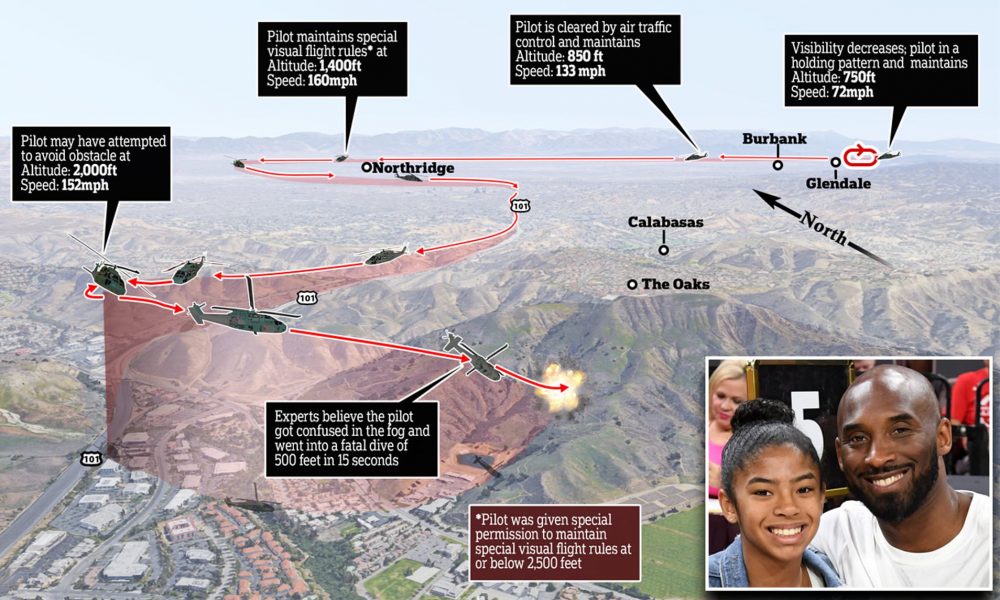It is no longer news that
Kobe Bryant, his 13-year-old daughter, Gianna, and 7 others passed away in a tragic
helicopter crash Sunday. Since then, more facts have emerged
which has given an insight to what caused the tragedy.
Key
Safety Feature Missing
According to a former pilot
for Bryant, Kurt Deetz, the Sikorsky S-76B is a luxury helicopter that can be
likened to a Cadillac Escalade. Having a veteran pilot at the controls should
have eliminated any worries about the occurrence of such an incidence.
“This model is a very sleek
craft as it comes with dual engines that are equipped with attractive
additional trimmings or features,” Deetz said.
However, according to a
National Transportation Safety Board (NTSB) official who pleaded anonymity, this
impressive chopper lacked a very crucial safety feature known as a TAWS or
terrain awareness and warning system.
The NTSB had long recommended
the installation of this safety feature on large passenger-carrying helicopters
since a Texas crash occurred in 2004. But unfortunately, nothing was done about
it.
Recovery
of the Bodies from the Helicopter Crash Site
The remains of the retired
NBA legend along with that of his 13-year-old daughter and the others have
now been recovered from the crash site. Their respective relatives have been
notified, as stated by LA County authorities.
NTSB investigators have
finished collecting evidence that led to the crash of the chopper Tuesday,
transporting wreckage out on several helicopters in large, white bags which
were trucked away from the debris field.
Cause
of Helicopter Crash Not Yet Determined
The specific cause of the
helicopter crash has not yet been determined; however, the gray and very thick
clouds that obscured most of the area last Sunday are being heavily scrutinized
as possible causes.
According to the NTSB board
member leading the investigation, Jennifer Homendy, “We are not just focusing
on weather. We are going to take a broad look at everything around this
accident.”
Homendy also stated that
Bryant’s chopper, besides the absence of the TAWS, also lacked a flight
recorder or what is generally known as “Black boxes” which could have aided
their investigations. The NTSB had once recommended the use of flight data as
well as cockpit recorders for helicopters, but the recommendation was not
heeded.
Despite this obvious snag,
investigators possess communications and radar tracking with air traffic
controllers. And they have been able to deduce that the chopper was flying using
nothing but visual reference and tracking the Southern California’s labyrinth
of freeways underneath them at approximately 1,400 feet.
And when the chopper was near
Burbank, California, almost halfway through the trip, Zobayan received
permission to fly at less than what is now considered minimum visibility which
is about 3 miles with a ceiling of 1,000 feet.
At such levels, radar
tracking was impossible. The chopper, however, rose to 2,300 feet, began a left
descending turn before it suddenly barreled into a very steep mountain slope at
high speed.
The impact the craft made
with the slope was so forceful that it left a crater on the face of the hill
while scattering wreckage over a wide area. The helicopter came to rest at
1,085 above sea level which is about 30 feet below the crest of the hill where
it struck.
Key
Questions Emerge
The following are some of the
crucial questions that have emerged as regards the chopper crash
- Was the private pilot, Ara Zobayan, flying the
chopper too fast – at over 150 miles per hour – and too low moments before the
crash?
- Did the helicopter, in spite of all the safety
features it came with, develop mechanical faults mid-air?
- Had the pilot become lost, no thanks to the
gray and thick clouds?
Hopefully, more facts will emerge
as investigations are still ongoing.

